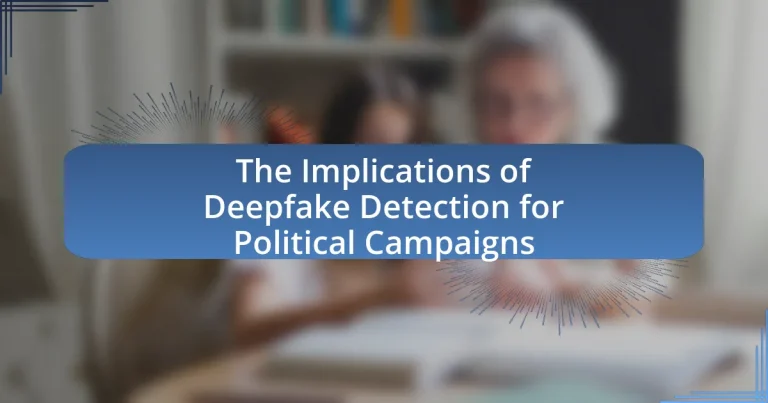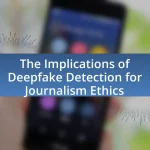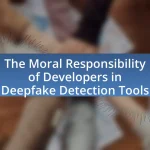The article examines the implications of deepfake detection for political campaigns, emphasizing its role in preserving electoral integrity and public trust. It discusses how deepfake technology can distort political discourse, influence voter perception, and pose risks such as misinformation and erosion of credibility. The article highlights the importance of effective detection tools in combating these threats, outlines strategies for political campaigns to implement detection measures, and explores future trends in technology that could enhance detection accuracy. Additionally, it addresses the need for public awareness and education to mitigate the impact of deepfakes on democratic processes.
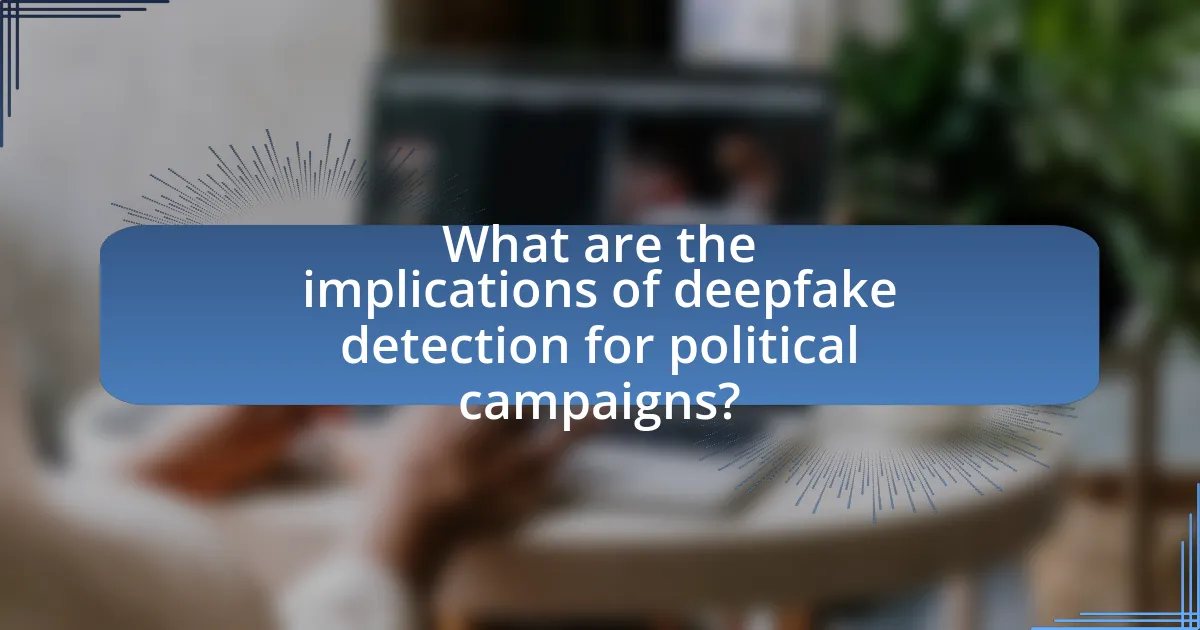
What are the implications of deepfake detection for political campaigns?
Deepfake detection has significant implications for political campaigns by enhancing the integrity of information disseminated to voters. Effective detection tools can prevent the spread of misleading content that could manipulate public perception and influence electoral outcomes. For instance, a study by the Stanford Internet Observatory found that deepfakes could undermine trust in political figures, leading to increased polarization and skepticism among the electorate. Furthermore, the ability to identify and counteract deepfakes can empower campaigns to protect their candidates’ reputations and maintain a fair electoral process. This capability is crucial in an era where misinformation can rapidly spread through social media, potentially swaying voter decisions based on fabricated narratives.
How does deepfake technology impact political discourse?
Deepfake technology significantly impacts political discourse by enabling the creation of hyper-realistic but fabricated audio and video content that can mislead the public. This manipulation can distort political messages, create false narratives, and undermine trust in legitimate media sources. For instance, a study by the University of California, Berkeley, found that deepfakes can decrease the perceived credibility of political figures, as 70% of participants expressed doubt about the authenticity of videos after being exposed to deepfake technology. This erosion of trust can lead to increased polarization and misinformation, ultimately affecting voter behavior and democratic processes.
What are the potential risks associated with deepfakes in politics?
The potential risks associated with deepfakes in politics include the spread of misinformation, erosion of public trust, and manipulation of electoral outcomes. Misinformation can be disseminated rapidly through deepfakes, leading to false narratives that mislead voters. For instance, a deepfake video of a political candidate making inflammatory statements could influence public perception and voting behavior. The erosion of public trust occurs as citizens become increasingly skeptical of authentic media, making it difficult to discern truth from fabrication. A study by the Brookings Institution highlights that 70% of Americans express concern about the impact of deepfakes on democracy. Additionally, deepfakes can be weaponized to undermine political opponents, creating a landscape where electoral integrity is compromised.
How can deepfakes influence voter perception and behavior?
Deepfakes can significantly influence voter perception and behavior by creating misleading representations of political figures, which can alter public opinion and voting decisions. For instance, a deepfake video that falsely depicts a candidate making controversial statements can lead to a decline in their support, as seen in the 2020 U.S. elections where misinformation spread rapidly through social media platforms. Research indicates that 85% of voters are concerned about the impact of deepfakes on elections, highlighting their potential to manipulate perceptions and sway voter behavior.
Why is deepfake detection crucial for maintaining electoral integrity?
Deepfake detection is crucial for maintaining electoral integrity because it helps prevent the spread of misinformation that can manipulate public opinion and influence election outcomes. The rise of deepfake technology has made it increasingly easy to create realistic but false representations of candidates, which can mislead voters and undermine trust in the electoral process. For instance, a study by the University of California, Berkeley, found that 85% of participants were unable to distinguish between real and deepfake videos, highlighting the potential for deepfakes to deceive the electorate. By effectively detecting and mitigating deepfakes, electoral bodies can safeguard democratic processes and ensure that voters make informed decisions based on accurate information.
What role does deepfake detection play in combating misinformation?
Deepfake detection plays a crucial role in combating misinformation by identifying and mitigating the spread of manipulated media that can mislead the public. The technology enables the verification of video and audio content, ensuring that individuals can discern authentic information from deceptive representations. For instance, a study by the University of California, Berkeley, found that deepfake detection tools can achieve over 90% accuracy in identifying altered videos, thereby significantly reducing the potential for misinformation to influence public opinion and political discourse. This capability is essential in political campaigns, where the integrity of information directly impacts voter perception and decision-making.
How can deepfake detection tools enhance trust in political communications?
Deepfake detection tools enhance trust in political communications by verifying the authenticity of video content, thereby reducing the spread of misinformation. These tools utilize advanced algorithms to analyze visual and audio elements, identifying inconsistencies that indicate manipulation. For instance, a study by the University of California, Berkeley, demonstrated that deepfake detection algorithms could achieve over 90% accuracy in identifying altered videos, which helps to reassure the public about the integrity of political messages. By providing a reliable means to discern genuine content from fabricated material, these tools foster a more informed electorate and promote accountability among political figures.
What challenges do political campaigns face regarding deepfake detection?
Political campaigns face significant challenges regarding deepfake detection, primarily due to the rapid advancement of deepfake technology that outpaces detection methods. The sophistication of deepfake algorithms makes it increasingly difficult for campaigns to identify manipulated content, leading to potential misinformation and erosion of public trust. For instance, a study by the University of California, Berkeley, found that deepfake detection tools have a detection accuracy rate of only about 65%, highlighting the limitations in current technology. Additionally, the sheer volume of content generated during campaigns complicates the monitoring process, as campaigns struggle to keep up with the constant influx of media. This combination of advanced manipulation techniques and inadequate detection capabilities poses a serious threat to the integrity of political discourse.
How can campaigns effectively implement deepfake detection strategies?
Campaigns can effectively implement deepfake detection strategies by utilizing advanced machine learning algorithms and collaborating with technology firms specializing in digital forensics. These algorithms analyze video and audio content for inconsistencies that indicate manipulation, such as unnatural facial movements or audio mismatches. Research from the University of California, Berkeley, highlights that machine learning models can achieve over 90% accuracy in detecting deepfakes by training on large datasets of both authentic and manipulated media. Additionally, campaigns should establish partnerships with platforms like Facebook and Twitter, which are developing their own detection tools, to ensure rapid identification and removal of deepfake content. This proactive approach not only safeguards the integrity of the campaign but also builds public trust by demonstrating a commitment to transparency and authenticity.
What are the limitations of current deepfake detection technologies?
Current deepfake detection technologies face significant limitations, primarily in their ability to accurately identify high-quality deepfakes. These technologies often struggle with detecting subtle manipulations, especially as deepfake generation techniques continue to evolve and improve. For instance, many detection algorithms rely on specific artifacts or inconsistencies that may not be present in more sophisticated deepfakes, leading to false negatives. Additionally, the rapid advancement of generative models, such as GANs (Generative Adversarial Networks), outpaces the development of detection methods, making it challenging to keep detection tools effective. Research indicates that as of 2023, detection accuracy can drop significantly when faced with new deepfake techniques, highlighting the ongoing arms race between deepfake creation and detection.
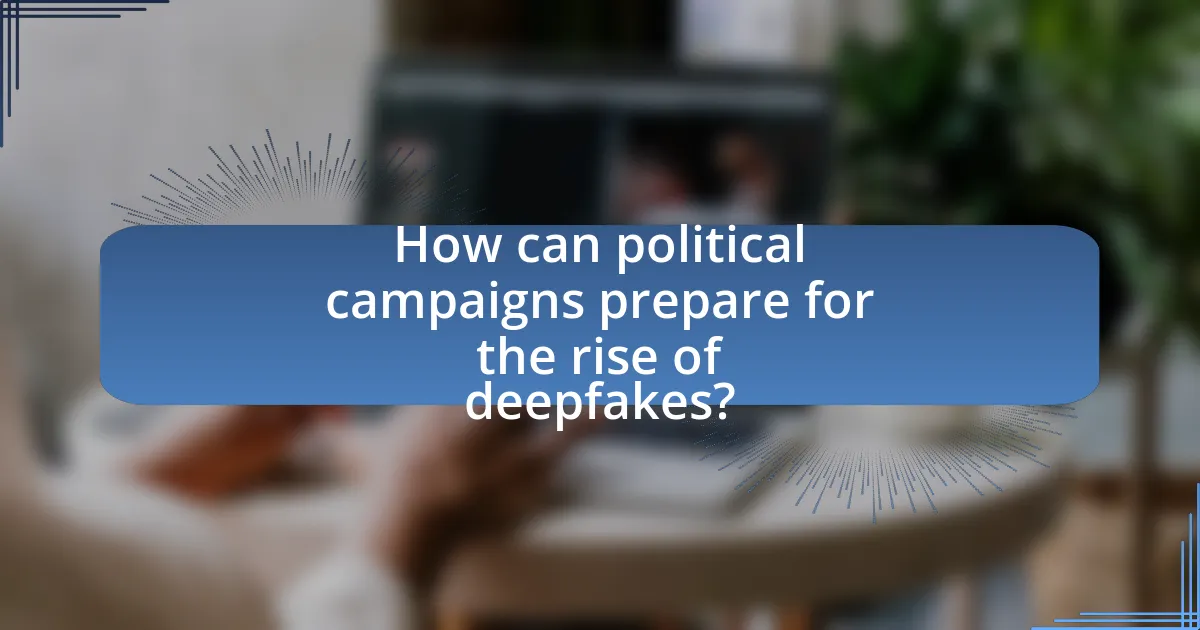
How can political campaigns prepare for the rise of deepfakes?
Political campaigns can prepare for the rise of deepfakes by implementing robust media literacy programs and investing in advanced detection technologies. Media literacy initiatives educate voters about the existence and potential impact of deepfakes, fostering critical thinking skills that help them discern authentic content from manipulated media. For instance, a study by the Pew Research Center found that 86% of Americans believe misinformation is a major problem, highlighting the need for informed voters.
Additionally, campaigns should collaborate with tech companies to utilize AI-driven tools that can identify deepfake content quickly and accurately. Research from the University of California, Berkeley, indicates that deepfake detection algorithms can achieve over 90% accuracy in identifying manipulated videos, demonstrating the effectiveness of such technologies. By combining education and technology, political campaigns can mitigate the risks posed by deepfakes and maintain the integrity of their messaging.
What strategies can campaigns adopt to mitigate deepfake risks?
Campaigns can mitigate deepfake risks by implementing robust verification processes for media content. This includes utilizing advanced detection technologies that analyze video and audio for signs of manipulation, such as inconsistencies in pixel patterns or audio anomalies. Research from the University of California, Berkeley, highlights that machine learning algorithms can effectively identify deepfakes with over 90% accuracy when trained on diverse datasets. Additionally, campaigns should prioritize media literacy initiatives to educate the public on recognizing deepfakes, thereby reducing the potential impact of misinformation. By combining technological solutions with public awareness efforts, campaigns can create a more resilient information environment against deepfake threats.
How can campaigns educate voters about deepfake threats?
Campaigns can educate voters about deepfake threats by implementing targeted informational initiatives that raise awareness and provide resources for identifying manipulated media. These initiatives can include workshops, social media campaigns, and partnerships with fact-checking organizations to disseminate information on how to recognize deepfakes and understand their potential impact on political discourse. Research indicates that misinformation, including deepfakes, can significantly influence public opinion and voter behavior, making education crucial for informed decision-making. For example, a study by the Stanford Internet Observatory found that 85% of participants were unable to identify deepfake videos, highlighting the need for effective educational strategies.
What partnerships can campaigns form to enhance deepfake detection efforts?
Campaigns can enhance deepfake detection efforts by forming partnerships with technology companies, academic institutions, and fact-checking organizations. Collaborating with technology companies allows campaigns to access advanced algorithms and tools specifically designed for deepfake detection, such as those developed by companies like Microsoft and Facebook, which have invested in AI research to combat misinformation. Partnering with academic institutions can provide campaigns with cutting-edge research and expertise in media forensics, as seen in collaborations with universities that focus on digital media studies. Additionally, working with fact-checking organizations can help campaigns verify the authenticity of content in real-time, leveraging their established credibility and resources to counteract misinformation effectively. These partnerships create a multi-faceted approach to identifying and mitigating the impact of deepfakes in political discourse.
How can campaigns leverage technology to combat deepfakes?
Campaigns can leverage technology to combat deepfakes by utilizing advanced detection algorithms and blockchain verification systems. Detection algorithms, such as those developed by researchers at the University of California, Berkeley, analyze video and audio for inconsistencies that indicate manipulation, achieving accuracy rates above 90%. Blockchain technology can provide a secure and immutable record of original content, allowing audiences to verify the authenticity of videos and images. By integrating these technologies, campaigns can enhance their credibility and protect their messaging from the harmful effects of deepfakes.
What tools are available for real-time deepfake detection?
Several tools are available for real-time deepfake detection, including Deepware Scanner, Sensity AI, and Microsoft Video Authenticator. Deepware Scanner utilizes machine learning algorithms to analyze videos for signs of manipulation, while Sensity AI employs a combination of computer vision and deep learning techniques to identify deepfake content. Microsoft Video Authenticator assesses images and videos to provide a confidence score regarding their authenticity. These tools are designed to combat the growing threat of deepfakes, particularly in sensitive areas like political campaigns, where misinformation can significantly impact public perception and trust.
How can data analytics support deepfake detection initiatives?
Data analytics can significantly enhance deepfake detection initiatives by enabling the identification of patterns and anomalies in digital content. By analyzing large datasets of video and audio files, data analytics tools can detect inconsistencies in facial movements, voice modulation, and other characteristics that are often manipulated in deepfakes. For instance, machine learning algorithms can be trained on authentic and deepfake datasets to improve accuracy in distinguishing between genuine and altered media. Research has shown that employing data analytics techniques, such as convolutional neural networks, can achieve detection rates exceeding 90% in controlled environments. This statistical evidence underscores the effectiveness of data analytics in combating the spread of deepfakes, particularly in sensitive contexts like political campaigns, where misinformation can have significant consequences.
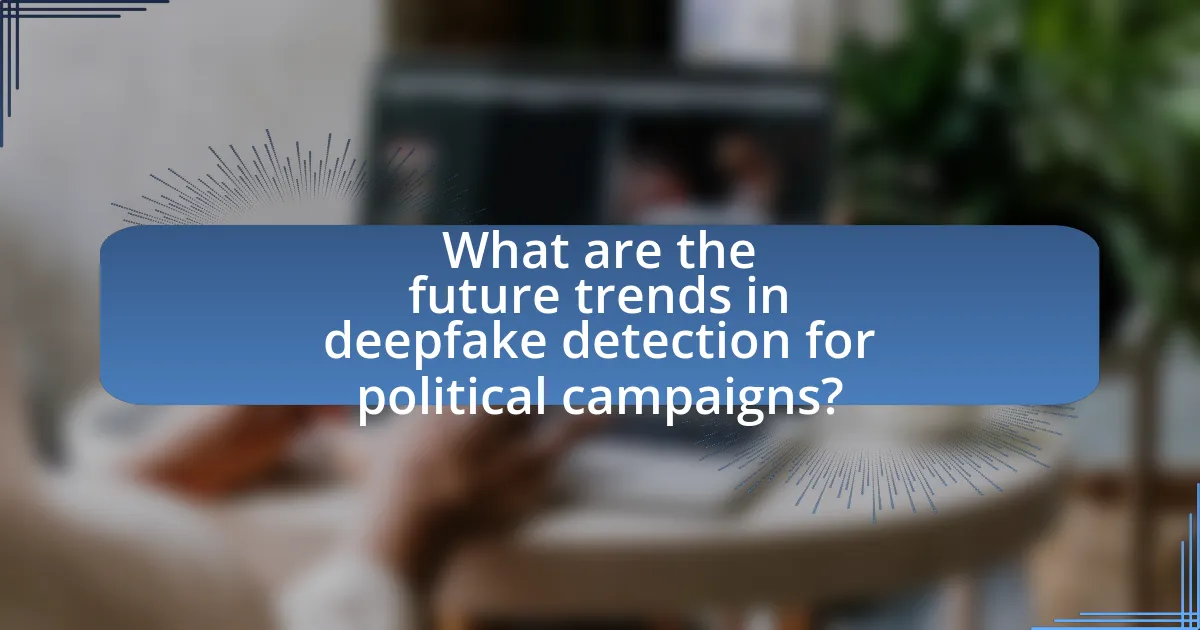
What are the future trends in deepfake detection for political campaigns?
Future trends in deepfake detection for political campaigns include the development of advanced machine learning algorithms, real-time detection systems, and increased collaboration between technology companies and governmental organizations. These trends are driven by the growing sophistication of deepfake technology, which has been shown to deceive audiences effectively, as evidenced by the rise in misinformation during recent elections. Enhanced detection methods, such as the use of blockchain for content verification and AI-based tools that analyze audio-visual inconsistencies, are being prioritized to combat the potential manipulation of public opinion. Additionally, regulatory frameworks are expected to evolve, mandating transparency in political advertising and the disclosure of synthetic media, thereby reinforcing the integrity of electoral processes.
How might advancements in AI affect deepfake detection?
Advancements in AI are likely to enhance deepfake detection by improving the accuracy and speed of identifying manipulated media. Machine learning algorithms can analyze vast datasets of authentic and deepfake content, allowing for the development of sophisticated models that recognize subtle inconsistencies in video and audio. For instance, research has shown that AI systems can achieve over 90% accuracy in detecting deepfakes by examining facial movements and audio-visual synchronization. As these technologies evolve, they will become more adept at distinguishing between genuine and altered content, thereby playing a crucial role in safeguarding the integrity of political campaigns against misinformation.
What emerging technologies could improve detection accuracy?
Emerging technologies that could improve detection accuracy include artificial intelligence (AI) and machine learning algorithms, which enhance the ability to identify deepfakes by analyzing patterns and inconsistencies in video and audio data. For instance, AI models trained on large datasets of authentic and manipulated media can detect subtle artifacts that are often imperceptible to human observers. Research conducted by the University of California, Berkeley, demonstrated that deep learning techniques could achieve over 90% accuracy in distinguishing between real and fake videos, showcasing the potential of these technologies in improving detection capabilities.
How can political campaigns stay ahead of evolving deepfake tactics?
Political campaigns can stay ahead of evolving deepfake tactics by investing in advanced detection technologies and fostering media literacy among voters. Implementing AI-driven tools that analyze video and audio content for signs of manipulation can help identify deepfakes before they spread. For instance, companies like Deeptrace and Sensity AI provide solutions that detect deepfake content with high accuracy, enabling campaigns to respond swiftly to misinformation. Additionally, educating the electorate about deepfakes and their potential impact on democracy can empower voters to critically evaluate the media they consume, reducing the effectiveness of deceptive content. Research from the Stanford Internet Observatory highlights that informed voters are less likely to be swayed by manipulated media, reinforcing the importance of proactive measures in combating deepfake threats.
What best practices should campaigns follow for deepfake detection?
Campaigns should implement a multi-faceted approach for deepfake detection that includes using advanced detection technologies, educating staff and the public, and establishing clear protocols for response. Advanced detection technologies, such as machine learning algorithms and forensic analysis tools, can identify inconsistencies in video and audio that indicate manipulation. Educating staff and the public about the characteristics of deepfakes enhances awareness and critical viewing skills, reducing the likelihood of misinformation spreading. Establishing clear protocols for response ensures that campaigns can quickly address and counteract the dissemination of deepfakes, thereby protecting their integrity and public trust. These practices are supported by research indicating that proactive measures significantly reduce the impact of misinformation in political contexts.
How can campaigns create a proactive response plan for deepfake incidents?
Campaigns can create a proactive response plan for deepfake incidents by establishing a dedicated monitoring team that utilizes advanced detection technologies to identify deepfakes in real-time. This team should be trained to analyze content across various platforms and respond swiftly to any detected deepfake, ensuring that misinformation is addressed before it spreads. Additionally, campaigns should develop a communication strategy that includes pre-prepared statements and fact-checking resources to counteract the effects of deepfakes. Research indicates that timely responses can mitigate the impact of misinformation, as seen in studies where rapid rebuttals reduced the spread of false information by up to 70%. By implementing these measures, campaigns can effectively safeguard their integrity and maintain public trust.
What role does public awareness play in deepfake detection success?
Public awareness significantly enhances deepfake detection success by equipping individuals with the knowledge to identify manipulated media. When the public is informed about the existence and characteristics of deepfakes, they are more likely to scrutinize content critically, reducing the likelihood of being misled. Research indicates that increased awareness leads to a higher detection rate; for instance, a study published in the journal “Computers in Human Behavior” found that participants who received training on deepfake identification improved their detection accuracy by over 50%. This highlights that informed audiences can act as a first line of defense against misinformation in political campaigns, ultimately fostering a more discerning electorate.
